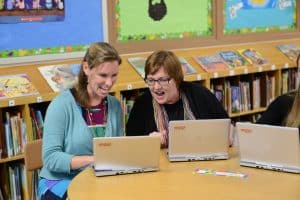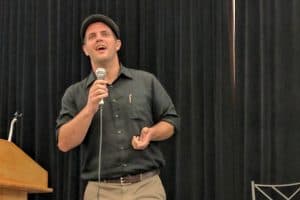
This column is one in a multipart American Libraries series that explores the library profession’s relationship to sustainability.
Supporting campus sustainability efforts through information literacy can be a fascinating experience for instruction librarians. For the past two years, I have been embedded in California State University, Fresno’s First-Year STEM program, a grant-funded project aimed at supporting graduation initiatives and retaining underrepresented communities and women in the fields of science, technology, engineering, and mathematics.
When I first started working at Fresno State as the first-year student success librarian in 2015, a colleague referred my name to a team of science professors in this program. From there, I began attending weekly meetings and contributing activities to be incorporated into STEM lesson plans throughout each semester. One of the most rewarding aspects of being embedded in this community was working closely with professors and teaching assistants from geology, chemistry, biology, and science education departments, since sustainability concerns multidisciplinary fields and perspectives.
Another reward was observing first-year STEM majors conducting original scientific research and making interesting connections and discoveries with scholarly articles on sustainability efforts. Each semester focused on a specific theme relating to sustainability, such as coffee, water, or campus environments. Coffee was a unique topic, for instance: Students conducted research and worked in groups to explore coffee as a global socioenvironmental system with the goal of providing recommendations for local, campus-based solutions related to coffee purchasing, consumption, and waste.
Water was a particularly relevant topic, as the state of California had been affected by an ongoing drought. Students researched California’s efforts toward a sustainable water plan and the complexity of the water system from different perspectives, including agricultural, economic, political, and cultural standpoints.
It was rewarding to observe first-year STEM majors conducting original scientific research and making interesting connections and discoveries with scholarly articles on sustainability efforts.
For a third semester, the theme was campus environments, where students conducted research on air quality, water use, soil chemistry, biodiversity, food sources used by dining halls, and waste management on campus. This narrowed, hyperlocal focus proved to be a deep learning experience for students, who saw how their research can make a difference in supporting sustainability on campus.
In my role, information literacy is a key component in fostering the curriculum and collaboration. Over the course of each semester, I showed more than 100 first-year students how to find and use library resources for their research. We covered the basics of primary and secondary sources in the sciences—new ground for these students who were more familiar with sources in the humanities. We explored different scholarly articles covering campus sustainability efforts and what action other university campuses are taking in the areas of waste management and biodiversity. We also spent time finding and interpreting charts and infographics, so students could create similar visuals for their projects. All of this information gave students ideas on how to evaluate and design their own experiments on campus and allowed them to understand how scientific articles are written and structured.
At the end of each semester, students presented research posters in groups based on specific topics related to campus sustainability. I attended the talks and participated in the evaluation process. Research posters cited references, which included scholarly journals and government information. During their presentations, some students compared their own research to case studies from other scientific articles, which earned them higher points based on the rubric. Perhaps the most gratifying part was seeing some of the students’ semester-long research findings: There is a strong need for biodiversity of insects and plants in campus soils; dining halls should consider creative ways to prevent further food waste in the cafeteria; to reduce air pollution on campus, the university should provide more shuttle buses and promote more carpool parking permits for students.
As a result of my collaboration with this program, I’ve designed several library workshops for other first-year students in special programs (such as the Educational Opportunity Program) focused on data literacy—how to find and interpret graphs, charts, and statistics—and, more broadly, finding primary sources in the sciences. I’ve been thinking about more opportunities to expand the library’s role in recognizing the global issue of sustainability beyond the classroom but, for now, being embedded in this community has been a fruitful process in demonstrating the value of library resources in supporting campus sustainability efforts.


